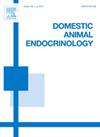Effects of rumen metabolite butyric acid on bovine skeletal muscle satellite cells proliferation, apoptosis and transcriptional states during myogenic differentiation
IF 1.9
2区 农林科学
Q2 AGRICULTURE, DAIRY & ANIMAL SCIENCE
引用次数: 0
Abstract
Butyric acid, a pivotal short-chain fatty acid in rumen digestion, profoundly influences animal digestive and locomotor systems. Extensive research indicates its direct or indirect involvement in the growth and development of muscle and fat cells. However, the impact of butyric acid on the proliferation and differentiation of bovine skeletal muscle satellite cells (SMSCs) remains unclear. This study aimed to elucidate the effects of butyrate on SMSCs proliferation and differentiation. After isolating, SMSCs were subjected to varying concentrations of sodium butyrate (NaB) during the proliferation and differentiation stages. Optimal treatment conditions (1 mM NaB for 2 days) were determined based on proliferative force, cell viability, and mRNA expression of proliferation and differentiation marker genes. Transcriptome sequencing was employed to screen for differential gene expression between 1 mM NaB-treated and untreated groups during SMSCs differentiation. Results indicated that lower NaB concentrations (≤1.0 mM) inhibited proliferation while promoting differentiation and apoptosis after a 2-day treatment. Conversely, higher NaB concentrations (≥2.0 mM) suppressed proliferation and differentiation and induced apoptosis. Transcriptome sequencing revealed differential expression of genes(ND1, ND3, CYTB, COX2, ATP6, MYOZ2, MYOZ3, MYBPC1 and ATP6V0A4,etc.) were associated with SMSCs differentiation and energy metabolism, enriching pathways such as Oxidative phosphorylation, MAPK, and Wnt signaling. These findings offer valuable insights into the molecular mechanisms underlying butyrate regulation of bovine SMSCs proliferation and differentiation, as well as muscle fiber type conversion in the future study.
瘤胃代谢物丁酸对牛骨骼肌卫星细胞增殖、凋亡和成肌分化过程中转录状态的影响
丁酸是瘤胃消化过程中一种重要的短链脂肪酸,对动物的消化和运动系统有着深远的影响。大量研究表明,丁酸直接或间接参与了肌肉和脂肪细胞的生长和发育。然而,丁酸对牛骨骼肌卫星细胞(SMSCs)增殖和分化的影响仍不清楚。本研究旨在阐明丁酸对SMSCs增殖和分化的影响。分离SMSCs后,在增殖和分化阶段将其置于不同浓度的丁酸钠(NaB)中。根据增殖力、细胞活力以及增殖和分化标记基因的mRNA表达,确定了最佳处理条件(1 mM NaB 2天)。在 SMSCs 分化过程中,采用转录组测序筛选 1 mM NaB 处理组和未处理组之间的基因表达差异。结果表明,较低浓度的 NaB(≤1.0 mM)会抑制增殖,同时促进分化和凋亡。相反,较高浓度的 NaB(≥2.0 mM)会抑制增殖和分化,并诱导细胞凋亡。转录组测序显示,与SMSCs分化和能量代谢相关的基因(ND1、ND3、CYTB、COX2、ATP6、MYOZ2、MYOZ3、MYBPC1和ATP6V0A4等)表达存在差异,丰富了氧化磷酸化、MAPK和Wnt信号转导等通路。这些发现为今后研究丁酸盐调控牛SMSCs增殖和分化以及肌纤维类型转换的分子机制提供了有价值的见解。
本文章由计算机程序翻译,如有差异,请以英文原文为准。
求助全文
约1分钟内获得全文
求助全文
来源期刊

Domestic animal endocrinology
农林科学-奶制品与动物科学
CiteScore
5.50
自引率
4.80%
发文量
58
审稿时长
31 days
期刊介绍:
Domestic Animal Endocrinology publishes scientific papers dealing with the study of the endocrine physiology of domestic animal species. Those manuscripts utilizing other species as models for clinical or production problems associated with domestic animals are also welcome.
Topics covered include:
Classical and reproductive endocrinology-
Clinical and applied endocrinology-
Regulation of hormone secretion-
Hormone action-
Molecular biology-
Cytokines-
Growth factors
 求助内容:
求助内容: 应助结果提醒方式:
应助结果提醒方式:


